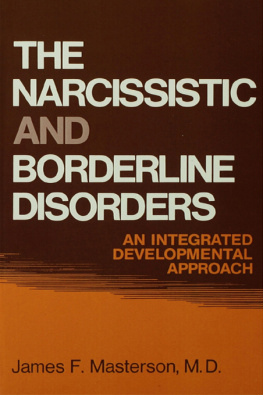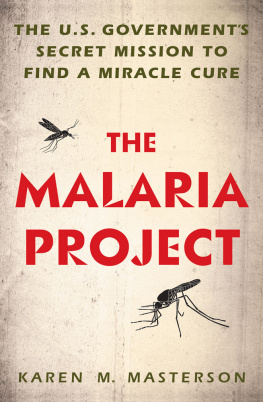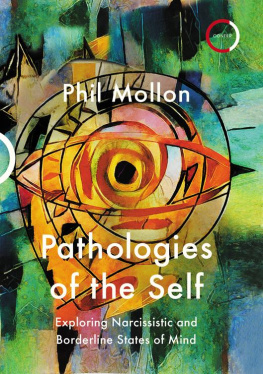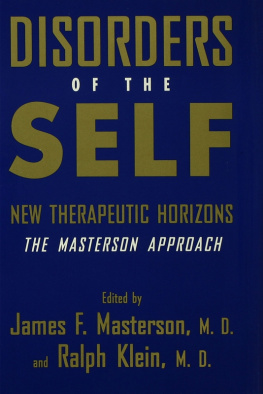Masterson - The Narcissistic and Borderline Disorders: an Integrated Developmental Approach
Here you can read online Masterson - The Narcissistic and Borderline Disorders: an Integrated Developmental Approach full text of the book (entire story) in english for free. Download pdf and epub, get meaning, cover and reviews about this ebook. City: London, year: 2014, publisher: Taylor & Francis (CAM);Routledge, genre: Romance novel. Description of the work, (preface) as well as reviews are available. Best literature library LitArk.com created for fans of good reading and offers a wide selection of genres:
Romance novel
Science fiction
Adventure
Detective
Science
History
Home and family
Prose
Art
Politics
Computer
Non-fiction
Religion
Business
Children
Humor
Choose a favorite category and find really read worthwhile books. Enjoy immersion in the world of imagination, feel the emotions of the characters or learn something new for yourself, make an fascinating discovery.
- Book:The Narcissistic and Borderline Disorders: an Integrated Developmental Approach
- Author:
- Publisher:Taylor & Francis (CAM);Routledge
- Genre:
- Year:2014
- City:London
- Rating:3 / 5
- Favourites:Add to favourites
- Your mark:
- 60
- 1
- 2
- 3
- 4
- 5
The Narcissistic and Borderline Disorders: an Integrated Developmental Approach: summary, description and annotation
We offer to read an annotation, description, summary or preface (depends on what the author of the book "The Narcissistic and Borderline Disorders: an Integrated Developmental Approach" wrote himself). If you haven't found the necessary information about the book — write in the comments, we will try to find it.
The Narcissistic and Borderline Disorders: an Integrated Developmental Approach — read online for free the complete book (whole text) full work
Below is the text of the book, divided by pages. System saving the place of the last page read, allows you to conveniently read the book "The Narcissistic and Borderline Disorders: an Integrated Developmental Approach" online for free, without having to search again every time where you left off. Put a bookmark, and you can go to the page where you finished reading at any time.
Font size:
Interval:
Bookmark:

The Narcissistic and Borderline Disorders
An Integrated Developmental Approach
The Narcissistic and Borderline Disorders
An Integrated Developmental Approach
By
James F. Masterson, M.D.

Published in 1981 by Routledge Taylor & Francis Group 270 Madison Avenue New York, NY 10016 | Published in Great Britain by Routledge Taylor & Francis Group 2 Park Square Milton Park, Abingdon Oxon OX14 4RN |
1981 by Taylor & Francis Group, LLC
Routledge is an imprint of Taylor & Francis Group
Printed in the United States of America on acid-free paper
28 27 26 25 24 23 22 21 20
International Standard Book Number-10: 0-87630-292-4 (Hardcover)
International Standard Book Number-13: 978-0-87630-292-7 (Hardcover)
Library of Congress catalog number: 81-38540
No part of this book may be reprinted, reproduced, transmitted, or utilized in any form by any electronic, mechanical, or other means, now known or hereafter invented, including photocopying, microfilming, and recording, or in any information storage or retrieval system, without written permission from the publishers.
Trademark Notice: Product or corporate names may be trademarks or registered trademarks, and are used only for identification and explanation without intent to infringe.
Library of Congress Cataloging-in-Publication Data
Catalog record is available from the Library of Congress
| Visit the Taylor & Francis Web site at and the Routledge Web site at |
Contents
Introduction
A borderline patient reported: I have such a poor self-image and so little confidence in myself that I cant decide what I want, and when I do decide, I have even more difficulty doing it.
A narcissistic patient reported: I was denied promotion to chief executive by my board of directors, although my work was good, because they felt I had poor relations with my employees. When I complained to my wife, she agreed with the board, saying my relations with her and the children were equally bad. I dont understand. I know Im more competent than all these people.
These two statements vividly illustrate the wide spectrum of the psychopathology of the self (narcissism), which ranges from the deficient emotional investment in the self seen in the borderline to the pathologic overinvestment of the self seen in the narcissistic patient. Many a borderline patient reports being green with envy at the faade of self-confidence exhibited by the narcissistic patient.
Ignoring these key differences and seeing both disorders as one has created endless confusion (58-63). This book describes the differences between the two disorders in developmental level, intrapsychic structure and clinical picture and details the differences in therapeutic technique required to treat them.
The quantum leap in the understanding of the psychopathology of borderline and narcissistic disorders which has occurred in recent years has improved therapeutic techniques and led to better clinical results. This new understanding has sprung from, as well as stimulated, excursions into theory regarding how early development affects character formation: What factors are essential to normal development? What goes wrong with this course of events to produce a borderline syndrome or a narcissistic personality disorder?
The hypotheses for these theories have derived from three sources: (a) the psychoanalytic treatment of children; (b) anamnestic reconstructions from the analysis of borderline and narcissistic adults; and (c) direct child-observation research by analytic observers of normal childrenin vivo, so to speakas they passed through these early phases of development. Any theory of the borderline and narcissistic disorders, to have maximum explanatory power and appropriate and close clinical fit, should utilize both reconstruction from analysis and child observation studies of normal development. Even though these two sources differ in the nature of the data obtained and the method of study, their findings reinforce each other. Any theory, therefore, should comprise concepts derived from the developmental theory of symbiosis and separation-individuation (1, 2, 74, 76), as observed and described in normal development, as well as the pathology of the separation-individuation (72, 83, 96) process which produces various developmental arrests.
Most psychoanalytic authors (43-50; 58-63) emphasize only one source, the analytic evidence, to the exclusion of the developmental, and their theories suffer accordingly in both explanatory power and appropriate clinical fit. Kernberg has lately acknowledged that the child-observation studies on separation-individuation do reinforce his clinical evidence (48).
Many other authors, lacking a specific developmental focus, search in vain for answers to these patients problems in classical instinctual theory and oedipal conflict (see ). It is not that the latter are not involved or important. It is that their importance in these patients must be subordinated to and perceived through the developmental focus of an arrested separation-individuation.
In the borderline patient specifically, this means that the therapist must be guided or oriented by what I have called the borderline triad: Separation-individuation leads to depression which leads to defense. Clinical observations about self-and object representations instinctual-drive derivatives, ego functions and defense mechanisms, superego functions, fantasies, affective states, transference, and resistance must be organized around this essential theme. Again, this is not to say that other aspects are not important, but their importance must be subordinated to and organized around this theme.
Similarly, in the narcissistic patient, as described in , an understanding of the consequences of the separation-individuation failure is essential to conduct appropriate psychotherapy. This does not imply a whole new revolutionary meta-psychology that discards the old but, rather, a new, additional perspective to add to those already in existence.
The major thrust of this book is to demonstrate the clinical effectiveness of this developmental approach with the narcissistic and borderline personality disorders.
PART ITHE PSYCHOPATHOLOGY OF NARCISSISM
presents a new aspect of developmental theory: the narcissistic psychopathology (or psychopathology of the self) of the borderline patient and how it differs from that of the narcissistic personality disorder. It also describes the developmental theory and clinical picture of the borderline patient with a false self (117), contrasts this developmental view with that of Winnicott and then presents a detailed report of the psychoanalytic psychotherapy of two patients with a false self that illustrates the special technical treatment problems these patients present.
PART IITHE BORDERLINE PERSONALITY DISORDER
presents a revision and update of the developmental theory of the roles of maternal libidinal availability and separation-individuation in normal ego development and in the developmental arrest of the borderline. This revision stems from reflection and study prompted by questions raised regarding the theory in the last eight years, as well as from a review of related studies published over the same period.
Next pageFont size:
Interval:
Bookmark:
Similar books «The Narcissistic and Borderline Disorders: an Integrated Developmental Approach»
Look at similar books to The Narcissistic and Borderline Disorders: an Integrated Developmental Approach. We have selected literature similar in name and meaning in the hope of providing readers with more options to find new, interesting, not yet read works.
Discussion, reviews of the book The Narcissistic and Borderline Disorders: an Integrated Developmental Approach and just readers' own opinions. Leave your comments, write what you think about the work, its meaning or the main characters. Specify what exactly you liked and what you didn't like, and why you think so.














